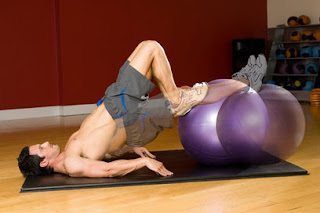On Feburary 1st 2013 we brushed
up on the basics of Athletic Core Conditioning. To review, my first
recommendation is that you understand what “neutral spine” is, and why this position is best for your spine on both day-to-day-posture and additionally strength training.
I introduced the analogy of the “core cylinder” in regards to muscle balance
around the whole torso to best protect your spine. And last I recommended training
multi-directional movements in all 3 three body planes avoid injury, dysfunction,
and/or poor performance.
Part Four: Breathe
When focusing on core training remember to breathe. And when I say “breathe”, I mean slow and controlled and timed so that your breath is fully exhaled when you complete your repetition. For many, this equates to moving a lot slower than what you might be used to. The reason is for twofold: The first is that your TVA (transverse abdominis) works synergistically with your diaphragm to get air in and out of your lungs, so training the muscles together in full range of motion is beneficial, and the second is that short choppy breaths are usually different from your usual pattern of breathing in exercise and less transferrable. Therefore training your TVA contraction with a full breath out you will be better able to control and tighten the corset like nature of your TVA, and enhance your most inner core muscles.
Nice TVA Curl
Part Five: Compound Muscle Movements
For the bulk of your core training try to
incorporate full body movement or compound muscle exercise instead of isolation
exercise. By choosing movements which employ your arms and legs in conjunction
to your core you will train a more natural system of movement and add extra
stability to your torso. For those unfamiliar with compound exercises, they
consist of multiple muscle groups over multiple joints. An example might be a
rotational cable twist, an overhead one arm snatch, dips, chin ups, or classic
squats. By training exercises that use your arms and legs at the same time as
your core, the benefit is greatly amplified through the intensity and specificity
of movement resembling to your athletic
endeavors.
A few core muscles commonly neglected in
the typical abdominal crunch routine is the transverse abdominis, Psoas, iliacus, and
multifidus. They are found deeper in the core and are important because the
offer more spine stability and hip stability. When you only complete the typical core
crunch these muscles are somewhat neglected.
Furthermore, if left untrained …. ( as the rest of the body
develops), the resulting muscle imbalance can be painful and confusing. Use the
TVA crunches described above, and also employ a (face down) prone ball jackknives over
a swiss ball to improve the illopsoas. For the multifidus muscles, do a slow,
smooth, and complete (face down) prone back extension over a swiss ball. Use
every segment of your vertebrae to reach full extension to innervate all the
multifidus and hold for a moment at the end with the low back (quadratus lumborum).
That should do the trick.
Seven: Better Core means Better Balance. (And vice versa)



















No comments:
Post a Comment